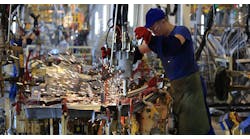In my previous writings, I have discussed the use of leverage as an OEM negotiating strategy. As you may recall, a focus of IndustryWeek’s supply chain strategy is to provide thought leadership on OEM strategic supply management practices through giving visibility on how changes in their practices can positively impact company financials, above and beyond lower piece-prices. The following article, updated from a 2015 piece I wrote, elaborates on this subject.
Leverage is a tool that rarely produces optimal results, unless the result you want is to antagonize your suppliers.
Obtaining leverage is often portrayed as something akin to either a silver bullet or the Holy Grail, with applying leverage in negotiations considered paramount to just about everything else. I disagree with this perspective.
Sports tend to be the ultimate in “win-lose” engagements, where each side considers the other to be an opponent. Win-lose negotiations are zero sum. This means that when one side gets more, the other side ends up with less. Leverage is the primary tool associated with zero-sum negotiations. In sports, a competitive aspect and win-lose outcome is understood and expected. As the Hall-of-Fame coach of my favorite professional football team once said, “Winning isn’t everything—it’s the only thing.” But is an OEM leverage-based win-lose negotiation strategy really the most effective way to work with suppliers?
I’ll switch sports now as I continue on with this vein of thought. You probably don’t need to be a fan of college wrestling—my favorite sport—to know what a half-nelson is. It is a hold where you use your arm as a lever to pry your opponent into positions he’d rather not be in. Wrestlers like to say that the ultimate goal of a wrestling match is to impose your will on an opponent. I think you can see where I’m going with this.
Using leverage in negotiations is akin to applying a wrestling hold that allows you to impose your will on those you are negotiating with. You might ask, “Who cares, as long as the prices go down? After all, isn’t that what supply management is all about?”
Actually, as I’ve written before, piece-price should usually not be seen as the whole story in a purchasing transaction. And leverage applied inappropriately can lead to unintended negative outcomes.
The Good
In my mind there are two good scenarios relative to the use of leverage in negotiations. The first is with economies-of-scale. When a supplier’s direct and/or overhead costs go down, the negotiation for lower prices is no longer a zero-sum game since piece-prices can go down without the supplier having to sacrifice financially. A primary tenet of mine was always “when costs go down, prices go down” and it seemed to play well with suppliers.
A second good scenario is with commodity-type products. Commodities are readily available from a multitude of sources. The reality with commodities is that leverage is the standard basis for negotiating their pricing and that because of this there will likely be winners and losers in every transaction. Customers usually have the bulk of the leverage. If you are considered a supplier of commodities by your customer, the onus is on you to demonstrate to them that the value you offer is really above and beyond just supplying parts.
The Bad
The difference between the good and the bad in use of leverage often involves answering the question, “What is a commodity?” Customers seem to like to characterize as many product types they can as commodities. It should probably be said that some OEMs regard all products they purchase as commodities. Suppliers, on the other hand, try to limit the definition of commodity to exclude what they are selling. Again, you might ask, “If applying leverage is effective in lowering piece-price, why shouldn’t all products be treated as commodities?” There are at least a couple of reasons.
First, it should be understood how commodities and non-commodities contribute to a customer’s Cost-of-Goods-Sold. Commodities are products that require little organizational support. For instance, a minimal amount of engineering resources are usually needed to design fasteners into a product. Consequently, the primary contribution off-the-shelf fasteners make to a product’s cost-of-goods-sold is through lower piece-prices.
Read more of Paul Ericksen's supply chain management articles
On the other hand, products that require organizational support such that piece-price does not adequately represent a supplier’s actual contribution to total cost are not commodities. The cost of this organizational support is usually hidden in customer overheads. The problem with using leverage in buying non-commodity products is that it is not an effective strategy for recognizing, quantifying and accounting for total cost, which can be an important differentiator between potential sources.
For instance, suppliers often try to compete by offering expertise in design and process engineering. They make suggestions to product specs and tolerances that would normally be considered the responsibility of their customer’s product engineering group and in doing so reduce both their customer’s need for engineering overhead and product cost. Most suppliers do not generally bill customers for this support instead wrapping it into their piece-price. Similarly, most customers would not want or accept a separate invoice for this type of support.
A year or two later someone—usually a cost accountant—not familiar with the supplier’s overall contribution may find that another supplier can manufacture the parts at a lower piece-price and so comes to the conclusion that the current supplier is not competitive. In other words, the customer does not comparing suppliers in an apples-to-apples manner in their sourcing decision.
The bottom line on the “bad” in leverage is that it isn’t an effective negotiating strategy for non-commodity products since it doesn’t recognize costs other than piece-price. Consequently, using leverage with non-commodity products can result in a form of fool’s gold savings where a customer’s material variance may look better but overall costs increase.
The Ugly
Customer leverage can increase substantially when a supplier allows their portion of overall business to increase such that they are overly dependent on them. Most supplier firms recognize, at least intellectually, that for many reasons it is not a good practice to have too much of your overall business with a single customer, i.e. put all of your eggs in one basket. Why? Because when customers achieve this type of position they can use the increased leverage this gives them to impose their will on their suppliers. Specifically, they lead on unsuspecting supplier firms through regular business practice to become more and more dependent on them, and then lower the boom.
I consider the above practice unethical. My advice to suppliers is that if you see this happening, avoid the short-term financial benefits it may provide.
The bottom line on leverage in negotiations is that it is a strategy that more often than not creates antagonistic relationships. This is okay when you’re in a wrestling match or, as in the case with commodities, when other comparable sources are readily available. But when customers have supplier-related costs that go beyond piece-price, leverage is a strategy that often doesn’t produce the optimal result.
Paul Ericksen is IndustryWeek’s supply chain advisor. He has 40 years of experience in industry, primarily in supply management at two large original equipment manufacturers.




